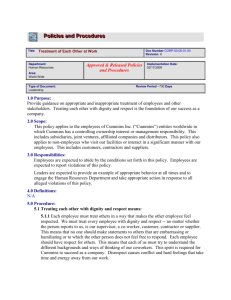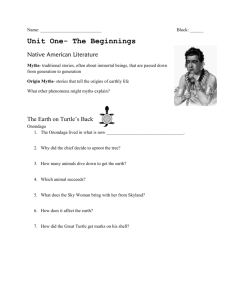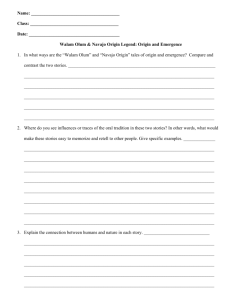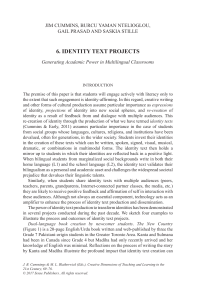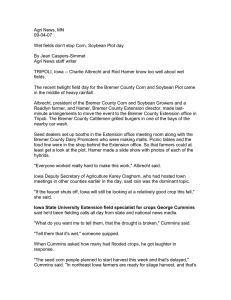Week 4-2 Culture Powerpoint - Northern Arizona University
advertisement
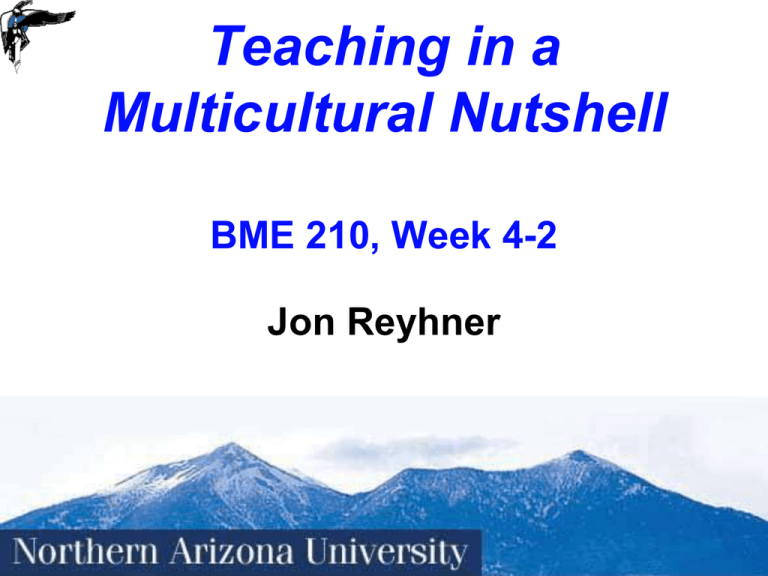
Teaching in a Multicultural Nutshell BME 210, Week 4-2 Jon Reyhner 1 2 The common transmission or direct instruction teaching approach (Paulo Friere’s “banking education”) using lectures and textbooks that forms the indoctrinating teaching methods and materials of many schools today do not help develop truly strong identities. Having students in an engaging education who thoughtfully experience and interact with their social and physical environment produces them. 3 University of Toronto Professor Jim Cummins describes this as a transformative teaching that enables “students to relate curriculum content to their individual and collective experience and to analyze broader social issues relevant to their lives.” This is a joint learning experience that involves both students and teachers in the learning process. 4 Cummins thinks that teachers must learn from their students as well as having the students learn from them. Linda Cleary and Thomas Peacock’s Collected Wisdom emphasizes this theme of “teacher as learner.” 5 Teachers need to learn about the lives of their students beyond the school grounds to learn more about the home language and culture of their students and see better the challenges that their students face in their lives. 6 Cummins emphasized in a speech to the National Association for Bilingual Education (NABE) in Phoenix in 2001 how the “English for the Children” Proposition 203 passed in Arizona by the voters in 2000 (and modeled after California’s earlier Proposition 227) reflected a “xenophobic discourse” that is telling students to “leave your language [and culture] outside the schoolhouse door.” 7 Dr. Cummins reviewed research and identified four factors needed to empower minority students who historically have not done well in school. 8 Instruction/Pedagogy Researchers have suggested that the learning difficulties of minority students are often caused by the way we teach children designated “at risk." These students frequently receive intensive instruction that confines them to a passive role and induces a form of “learned helplessness.” On the other hand, instruction that can empower students aims to liberate students from dependence on instruction in the sense of encouraging them to become active generators of their own knowledge. 9 EXPERIENTIAL-INTERACTIVE (TWO-WAY & ACTIVITY-CENTERED) INSTRUCTION 1. GENUINE DIALOGUE BETWEEN STUDENT AND TEACHER, BOTH ORAL AND WRITTEN 2. GUIDANCE AND FACILITATION RATHER THAN CONTROL OF STUDENT LEARNING BY TEACHER 3. ENCOURAGEMENT OF STUDENT-STUDENT TALK IN A COLLABORATIVE LEARNING CONTEXT 4. ENCOURAGEMENT OF MEANINGFUL LANGUAGE USE BY STUDENTS RATHER THAN CORRECTNESS OF SURFACE FORMS 5. CONSCIOUS INTEGRATION OF LANGUAGE USE AND DEVELOPMENT WITH ALL CURRICULAR CONTENT RATHER THAN TEACHING LANGUAGE AND OTHER CONTENT AS ISOLATED SUBJECTS 6. FOCUS ON DEVELOPING HIGHER LEVEL COGNITIVE SKILLS RATHER THAN FACTUAL RECALL 7. TASK PRESENTATION THAT GENERATES INTRINSIC RATHER THAN EXTRINSIC MOTIVATION "TALKING AND WRITING ARE THE MEANS TO LEARNING" —ADAPTED FROM THE WORK OF JIM CUMMINS 10 John Dewey added a short chapter on projects in the 1933 edition of his classic book How We Think. He wrote that “constructive occupations” or “projects” are characterized by the following: 1. Engage interest: “Unless the activity lays hold on the emotions and desires, unless it offers an outlet for energy that means something to the individual himself, his mind will turn in aversion from it, even though externally he keeps at it.” 2. Intrinsic worth: “ The activity must be worthwhile intrinsically. ” Projects must “ stand for something valuable in life itself.” 11 3. Awaken curiosity: The project must “awaken new curiosity and create a demand for information.” 4. Time span: “The project must involve a considerable time span for its adequate execution. The plan and the object to be gained must be capable of development, one thing leading on naturally to another. It is not a succession of unrelated acts, but is a consecutively ordered activity in which one step prepares the need for the next one and that one adds to, and carries further in a cumulative way, what has already been done.” 12 Problem Based Learning Traditional Approach Lecture Readings/Notes Practice Application Problem Based Learning Approach Application (Problem) Questioning Research/Dialogue Solution Instruction (ongoing as needed) 13 Problem Posing/Based Learning • In Public Schools: – introduced in Science and Mathematics education – increasing in popularity as it facilitates a more active learning process • student’s role – building the learning community • teacher’s role • performance assessment – why • selected to motivate students • provides real life context for learning • embeds skills and knowledge in a meaningful context 14 Problem Based Learning • Sample Students task: –Investigate the question of moving people through the Grand Canyon and create a solution to this problem. –You must propose a solution that is an alternative to the current system and to the proposed light rail system. –Your team will compete with other idea development teams in presenting a solution. 15 The Importance of Background Knowledge and Contextualization “I had four dates and I ate three of them.” Janet Allen recounts how she visited a middle school classroom in San Diego where a teacher read aloud Sciescka and Smith’s The True Story of the Three Little Pigs. When the wolf reminds readers that no one would leave a perfectly good ham dinner lying in the straw, one girl looked up at the teacher with an incredulous look and asked, “Pigs have ham in them?” 16 Navajo students interviewed at Monument Valley High School in the Navajo Nation asked what kind of teacher do you learn most from? Gave these responses. I learn the most from teachers who have hands-on projects. They listen to your ideas. They don’t make you feel uncomfortable when you talk to them. Teachers that explain new ideas and show new ideas on how to learn different things in different ways. Ones that show respect and teach me responsibility. She can always help and explain things when you don’t understand. I learn the most from strict teachers who give homework, who are 17 easy to be with, and have a good sense of humor. When asked “if you were a teacher, what will you do in your classroom? What wouldn’t you do?” their replies included. Teach kids, be honest, and I wouldn’t yell at my students. I will have to be patient. As a teacher I will try to get to know each person individually. To see how they were doing at home and at school. Help them but never put them down, help them understand and make learning be fun and interesting. I will teach my class, treat them the way they 18 want to be treated. For the question, “What are some things that teachers do that may prevent you from learning?” they responded: Slams about their culture. Having boring lectures, talking too slow. Letting kids mess around or talk when someone else is talking They move through a section of work too fast and don’t explain the work, often speak too quickly and don’t repeat themselves. 19 In answer to the question, “Do you believe effective teachers need to be aware and sensitive of the culture of the students they are teaching?” An overwhelming response was in favor of cultural sensitivity. They believed it was important so that their culture was not made fun of and so that the teacher will not be put in an unknowing situation that could allow them to offend their students. However, some students expressed the fact that they still want to be taught the basic skills: “reading, math, writing, with culture not being a big issue.” 20 Dr. Lori Arviso Alvord, the First Navajo women surgeon “had An additional problem” in school besides attending a second rate public school. She writes in her 1999 autobiography the Scalpel and the Silver Bear that “Navajos are taught from the youngest age never to draw attention to ourselves. So Navajo children do not raise their hands in class. At a school like Dartmouth, the lack of participation was seen as a sign not of humility but lack of interest and a disengaged 21 attitude.” Karen Swisher, former president of Haskell Indian Nations University, recommends that “Above all, teachers must be …‘warm demanders,’ adults who balance humanistic concerns with high expectations for achievement. They must communicate an attitude of understanding and caring while at the same time demanding high performance.” 22 Some people tend to see success in life as a matter of luck, especially with the rise of Indian casino gambling and state lotteries. Other people find that the harder they work, the luckier they get. If you fall down six times, you just get up seven times. Persistence, self-discipline, and resilience built on a strong sense of identity—not luck and self-esteem—are the road to success. 23




